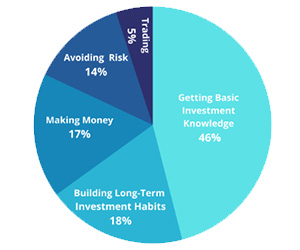
One of the best financial choices you can make is to begin investing when you are still a teenager. Your money will have more time to grow due to compound interest if you start early. You can start investing as a teenager with the help of this guide which will help you accumulate wealth and form lifelong sound financial habits.
1. Know Why It’s Important to Invest Early
Time is the strongest argument for beginning investing as a teenager. You have decades for your assets to develop when you start early. Over extended periods of time, compounding, the process by which your money generates returns and those returns generate returns, performs best.
For instance, if you invest $1,000 with 8% annual growth, it will grow to over $10,000 in 30 years without you having to make any additional investments. You can benefit from this exponential growth if you start early.
2. Discover the Fundamentals of Investing
It’s crucial to comprehend a few fundamental ideas before getting started.
- Stocks
You can purchase and own a piece of the shares of businesses.
- Bonds
Bonds are loans you make to businesses or governments in return for interest payments.
- Mutual Funds and Exchange-Traded Funds (ETFs)
Groups of equities or bonds that are professionally managed or follow an index.
- Compound Interest
The long-term driver of wealth accumulation.
Read books, watch videos online, and follow reliable financial professionals to educate yourself. Books for beginners include Robert Kiyosaki’s Rich Dad Poor Dad and Benjamin Graham’s The Intelligent Investor.
3. Establish Specific Financial Objectives
Setting clear objectives for your investing will help you stay on track. Consider the following aspects.
- What motivates me to invest? For instance, going to college, purchasing a vehicle, or accumulating wealth.
- How long will it take me to invest? Long-term or short-term objectives.
- What level of risk am I prepared to accept?
Understanding these responses can assist you in selecting investing solutions that best suit your goals.
4. Create an Investment Account
To begin investing as a teenager, you’ll probably need a custodial account. Until you reach the age of majority that is often 18 or 21 depending on where you live, these accounts are run by a parent or legal guardian. Your options could be as follows.
- Equities
Investing in equities, exchange-traded funds, and mutual funds is possible with a custodial brokerage account. These accounts are provided by platforms including Schwab, Vanguard, and Fidelity.
- Roth IRA
A fantastic choice if you have earned income is a custodial Roth IRA. After-tax money is used to make contributions and withdrawals are tax-free in retirement.
Look into the platforms to identify one with affordable costs, intuitive user interfaces and a wealth of instructional materials.
5. Begin With Little Steps and Maintain Consistency
You don’t need much money to begin investing. Many sites enable you to start from as little as $10. Focus on consistency rather than quantity. Commit to investing some of the money you earn or receive as a gift.
For instance, invest $5 if you receive $20 as a gift and $20 if you make $100 from a part-time job. These little payments will mount up and become much more substantial over time.
6. Spread Out Your Investments
To lower risk, diversification entails distributing your funds among several investment kinds. If you’re just starting out, think about using index funds or exchange-traded funds (ETFs) that follow the market as a whole. These funds offer wide exposure and are less hazardous than individual equities.
The S&P 500 Index Fund makes investments in 500 of the biggest American corporations. ETFs that provide exposure to the whole stock market are known as total market ETFs.
Having hundreds of assets isn’t necessary for diversity, a small number of carefully selected funds can offer sufficient variety.
7. Remain Patient and Refrain from Making Rash Decisions
Investing requires patience. There will be ups and downs in the stock market but perseverance is what counts. Steer clear of the current hot stock or resist the urge to sell when prices fall. Prioritize your objectives and keep in mind that timing the market isn’t as important as time in the market.
8. Observe Your Investments
Even though investing is typically a hands-off activity, it’s nevertheless crucial to occasionally review your portfolio. Establish a routine like evaluating your assets every three months. Examine the following.
- Performance
Do your assets live up to your standards?
- Diversification
Is there a balance in your portfolio?
- Fees
Are the costs you are paying fair?
If necessary, rebalance your portfolio to keep it in line with your objectives.
9. Utilize Tools and Technology
Utilize platforms and tools that make investing easier. Many include features tailored especially for novice investors.
- Fractional Shares
Use websites like Robinhood or Stash to purchase pieces of pricey equities.
- Automatic Investing
Configure your investing account to receive regular payments.
- Education
Learn about investing by utilizing the integrated resources.
Fidelity, Vanguard, Acorns, and M1 Finance are well-liked platforms for novices.
10. Recognize the Dangers and Safeguard Your Investments
There are hazards associated with investing but you can control them.
- Market Risk
Short-term value losses are possible for stocks and funds.
- Inflation Risk
Inflation has the potential to gradually reduce cash’s buying value.
To reduce risks, keep an emergency fund on hand for unforeseen costs and refrain from investing all of your money in one venture. Don’t invest more than you can afford to keep for years.
11. Benefit from Taxes
A custodial Roth IRA is an excellent choice if you qualify. While your earnings grow tax-free and withdrawals are tax-free in retirement, contributions are taxed now. Additionally, consider the tax ramifications of any dividends or profits from your assets.
12. Acquire Knowledge from Failures
No investor is perfect. You may choose an underperforming stock or act rashly while the market is down. Make use of these encounters as teaching moments. Think back on your mistakes and how you can do better.
13. Continue to Learn and Remain Informed
Being educated is essential since the financial world is always changing. Subscribe to investing blogs, keep up with reliable financial news sources, and think about participating in online forums to exchange concepts and tactics. You’ll become a more competent and self-assured investor with continued education.
14. Consider the Long Term and Have Big Dreams
Keep in mind that your adolescent investments are only the start. You will benefit from the knowledge and habits you develop now for many years to come. Consider the potential, establishing your own company, achieving financial independence, or retiring early. If you remain dedicated and disciplined, the possibilities are endless.
One effective strategy to have a stable financial future is to begin investing when you are still a teenager. You can maximize your early start by understanding the fundamentals, establishing objectives, beginning modestly, and maintaining consistency.
Have patience, keep yourself updated, and enjoy the ride. The earlier you start, the more successful you will be financially. The moment has come to act and begin making investments in your future and yourself.

Leave a Reply